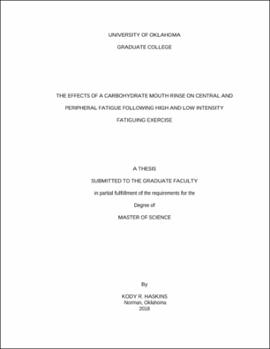| dc.description.abstract | Fatigue is the primary cause of the decline in performance during exercise. A carbohydrate (CHO) mouth rinse has been shown to have a beneficial effect during long duration, aerobic exercise. However, the effects of a CHO mouth rinse on resistance exercise is not well understood. PURPOSE: The primary purpose of this study was to determine the effects of a CHO mouth rinse on torque production and voluntary activation following high and low intensity isometric exercise performed to fatigue. METHODS: A total of 11 participants were recruited for this study who were all physically active. Each participant completed 6 visits, with 2 visits of familiarization, and 4 testing visits. A total of 9 maximal isometric contractions (MVC) were performed each visit. Three were performed prior to a high or a low-intensity fatiguing protocol. Three more were performed immediately after a fatiguing protocol and rinsing the mouth with either a CHO solution or placebo. The final 3 MVC’s were performed 5 minutes following the mouth rinsing. RESULTS: There were no significant interactions (p=0.31) between exercise intensity, time, and rinse condition on maximal torque. A significant intensity x time interaction (p = 0.004) on maximal torque was found. All six post-fatigue MVC’s were found to be significantly reduced over time following both the 20% (p < 0.003) and 80% (p < 0.01) fatiguing intensities. The 5-minute post fatigue MVC’s were found to be significantly different from the iPost MVC’s (p < 0.001). There were no significant findings for the 3-way interaction (rinse condition x fatigue intensity x time) on VA% (p = 0.59). A significant interaction (p = 0.005) was found for intensity x time. A one-way ANOVA showed a decrease in VA% over time following both the 20% (p < 0.001) and 80% (p = 0.02) fatiguing intensities. A significant main effect for time (p = 0.01) was found on TT. The three-way interaction of rinse condition x fatiguing intensity x time on RTD values was not significant (p = 0.47). The two-way interaction of fatiguing intensity x time was significant (p = 0.01) on RTD. RTD was not significantly different (p = 0.06) at the 20% of MVC fatiguing intensity over time. All six post-fatigue MVC’s were found to be significantly different from Pre (p < 0.03) for the 80% exercise intensity. RTD decreased for all three iPost MVC’s but increased compared to Pre and all iPost (p < 0.001) time points after 5-min of rest after the 80% exercise intensity. A one-way ANOVA showed no differences in RTD between the two exercise intensities for the seven time-points. The three-way interaction of rinse condition x fatiguing intensity x time on RTR values was not significant (p=0.41). The two-way interaction between fatiguing intensity and time on RTR was found to be significant (p = 0.002). When the data across the CHO and PLA conditions were collapsed the one-way ANOVA for the 20% fatiguing intensity over time was significant (p < 0.001). RTR in all three iPost time points were reduced in the 20% exercise intensity compared to Pre (p < 0.01) and compared to all three 5-min Post time points (p < 0.001). The three 5-min Post values for RTR were increased compared to Pre (p < 0.01). The one-way ANOVA for the 80% fatiguing intensity over time was significant (p < 0.001). The three initial iPost values for RTR were significantly reduced compared to Pre (p < 0.001) and compared to each of the three 5-min Post values (p < 0.001 for each; Figure 5). The three 5-minute Post values of RFR were not found to be significantly different (p > 0.29) from Pre. When compared between the 20% and 80% fatiguing protocols at each time point RFR values differed between the 20% and 80% protocols at iPost1 (p = 0.001), iPost2 (p = 0.004), iPost3 (p = 0.001), and 5-min Post3 (p = 0.03), but not 5-min Post 1 & 2 (p > 0.08). CONCLUSIONS: We were successful in eliciting both central and peripheral fatigue with our exercise conditions. However, rinsing the mouth with a CHO solution was found to not have a significant effect on maximal torque production or muscle recruitment. | en_US |
